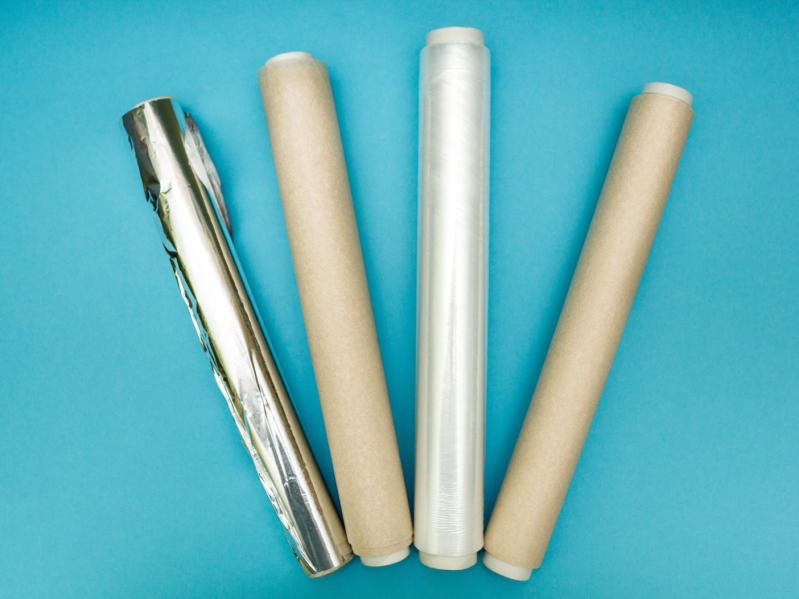We all have that drawer in our kitchen filled with boxes of foil, wax paper, and parchment paper ready for all our cooking and baking needs. While some of these products can be used interchangeably depending on the use case, they all serve unique and important roles in proper meal prep.
Videos by Suggest
Knowing when to use (and not use) wax paper, parchment paper, and aluminum foil can help prevent major kitchen disasters. Use this guide for best use cases—and absolute no-no’s.
Wax Paper: Prep, Storage, And Clean-up

Generally speaking, wax paper is a less common kitchen staple. Those who use it love it. But those who don’t normally get by just as easily.
Wax paper is often confused with a suitable substitute for parchment paper. However, this couldn’t be further from the truth! The number one rule with wax paper is never use it in the oven.
The reason is simple; think of a candle. Wax paper will melt in low heat and, at high temperatures, it can fully ignite.
Instead, use wax paper for prep, storage, and clean-up. It makes an easy-to-clean barrier between your counter and flour, sugar, and other messy ingredients. Wax paper is also great for rolling out dough and decorating baked goods.
Additionally, you can fold the wax paper into a funnel to easily transport finicky ingredients like chopped nuts or cheese.
Use wax paper for the temporary storage of butter, cheese, sandwiches, and other foods. If you’re freezing food, place a sheet of wax paper between layers to prevent them from sticking together.
Aluminum Foil: High Heat, Insulation, And Storage

Aluminum foil, on the other hand, is much more common. People often use foil to cover baking surfaces and wrap and store foods. While it’s a workhorse, aluminum foil is not meant for everything.
Foil is best suited for cooking things that require browning or intense heat. Aluminum reflects heat onto the food’s surface, making it great for roasted meat or crisp veggies.
But if you plan on using aluminum foil for roasting, be aware that it has no non-stick properties. Even foil labeled as non-stick can miss the mark sometimes. Prepare your sheet pan with oil or fat, or risk picking foil bits out of your potatoes.
Because of its reflective and non-stick properties, aluminum foil isn’t the best option for baked goods. Cookies, dessert bars, meringues, and other delicate treats should bake on silicon or parchment (more on that later).
Alternatively, aluminum can also act as a barrier when wrapped around food. It reflects the heat into the oven, away from the food’s surface. This helps protect pies and poultry–both of which brown more quickly than their insides cook–from burning.
In the same way, aluminum can trap heat. Use it to insulate dishes until the rest of the food is ready–because sometimes, timing doesn’t work out, no matter how well-intentioned we are.
Foil is also a decent cover for temporary cold storage. For long-lasting freshness, wrap foods entirely in foil. It can be tricky to get a tight enough seal using foil to cover a smooth container.
Finally, aluminum foil is the only material on this list that is safe to use on a grill.
Parchment Paper: Delicate Heat, Decorative Storage, And Clean-Up

If you’re a regular baker, then you likely already have parchment paper in your kitchen. Parchment paper is a crowd favorite for baking delicate food items like cookies, meringue, dessert bars, and more.
Parchment paper can withstand temperatures up to 420ºF—much hotter than is needed for most baked goods. Below 420ºF, the paper might darken, but it won’t burn. Still, it’s best to save parchment paper for delicate heat and easy clean-up.
Unlike foil, parchment paper is non-reflective and non-stick. These two qualities make it perfect for use in or out of the oven. Use the paper to temper chocolate or as a liner for no-bake treats. It also keeps the mess out of covering fruit, pretzels, and other treats in melted chocolate.
Parchment paper also makes baking clean-up a breeze. Line baking tins in parchment paper for effortless cake, brownie, and bread removal. If your recipe calls for a floured surface, parchment paper is a great non-stick option. Shake it out in the sink or trash to reuse.
When baking pies, be sure to keep parchment handy for blind bakes. The thin paper is a great barrier between your crust and pie weights to ensure a soft, even bake.
Some people use parchment paper for frozen food storage, however, I’ve found that wax paper works better. Parchment paper is more prone to tearing when you try to separate frozen layers.
Use unbleached parchment paper to beautifully wrap baked goods, knit items, and more for unique, boutique-quality wrapping paper.
